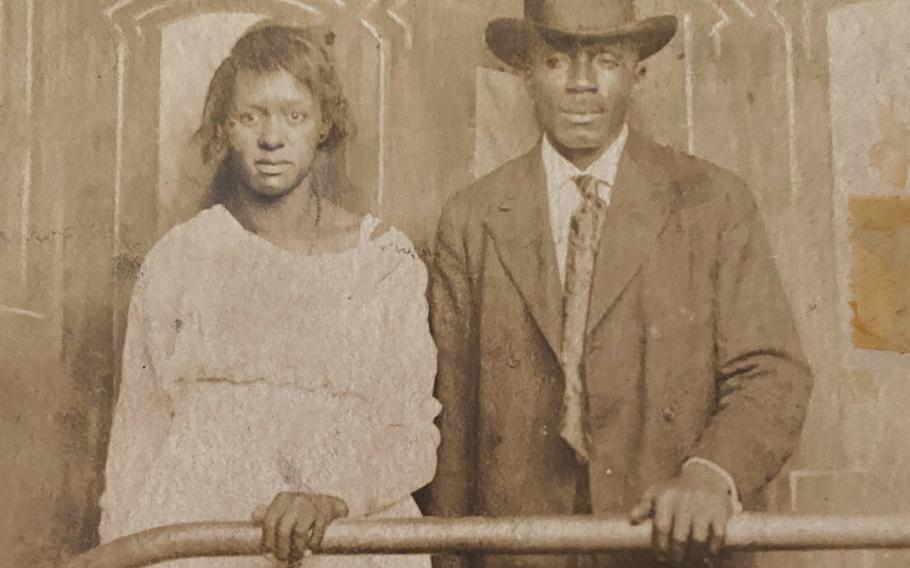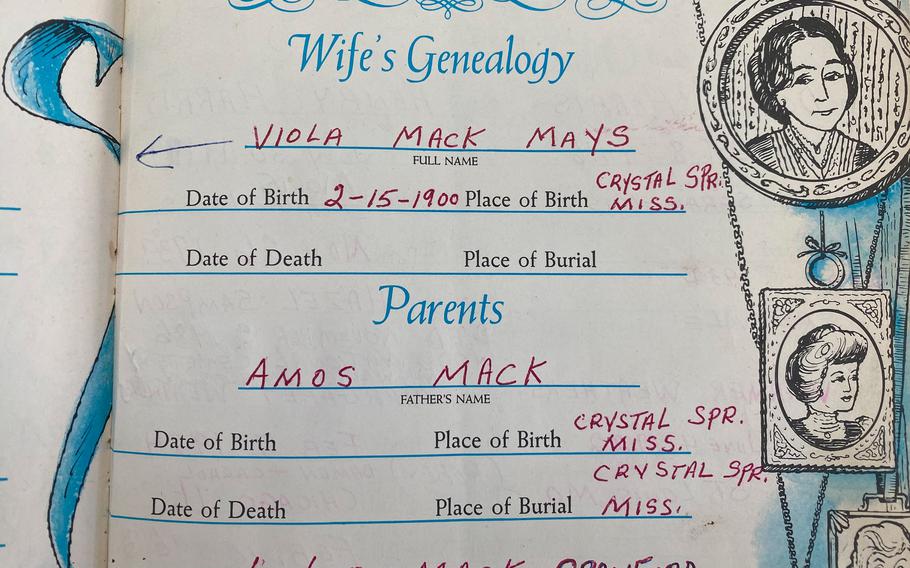
Sheeka Sanahori’s great-grandmother Viola Mays and an unnamed man in a postcard photo. Sanahori visited the spot this photo was likely taken, at the National Park Service’s museum in St. Louis, while retracing her ancestors’ Great Migration journey. (Sheeka Sanahori)
“Welcome to Yazoo, MS,” declares a bright red banner with white letters painted onto the side of a gas station. Yazoo City, Miss., was the Amtrak train’s first stop after leaving Jackson.
My face was glued to the train’s window. I was trying to memorize every church facade, empty lot and oak tree as the train picked up speed, heading north.
My 5-year-old son, Amir, was happily munching on snacks, excited to sleep on a train. I’d explained the significance of this trip, but I knew a deeper appreciation would develop once he was older. We were riding the train to retrace the journey north that our ancestors took on the Great Migration, paying homage to their brave decision to seek a better life.
I knew my ancestors’ train ride from Mississippi to Missouri would have been more arduous than mine, but I wondered whether this was the same landscape my family saw when they journeyed north. Many of them made the trek from across Mississippi to cities in the northern Midwest, but for simplicity’s sake, we followed the path most likely taken by my great-grandmother Viola Mays. Born in Crystal Springs, Miss., she first moved to St. Louis before heading farther north to Chicago a few years later.
An estimated 6 million Black Americans left their homes permanently in the South in a mass movement that scholars call the Great Migration. Families settled in cities such as Los Angeles, Chicago, Cleveland and New York from about 1910 to 1970. They were in search of better jobs than the South’s sharecropping system could provide. They were also attempting to escape racial terror.
“This movement of people is nearly unparalleled in American history. There are very few instances in which we have such a large number of people moving within the United States,” said Keneshia Grant, an associate professor of political science at Howard University who studies Black migration. “They are strategizing, they are calculating about their lives and how to make their lives better, and they’re doing it over an extended period of time.”
As the train pulled away, I clutched the framed black-and-white picture of my great-grandmother that I brought on our trip. Her choice to move deeply affected the life I have today.
Discovering family travels
I knew my great-grandmother; she was my oldest living relative before she died in her 90s. But the few memories I have with her are a blur from childhood. The strongest images I have come from the small details my father has shared about being raised by Mama Mays. He shared how she doted on plants, including her Moses-in-the-cradle that he propagated and still has today. He shared her recipe for collard greens and how she used to sell dinners in the neighborhood for extra cash.
My dad gave me a picture of Mama Mays proudly standing behind the counter of her own restaurant. I imagined her triumph of a dream realized.
Of all the beautiful details I’ve collected about her, the part I don’t know much about is her story on the Great Migration. To retrace her steps, I needed to research my family’s history. For those interested in doing the same, there are several avenues you can take to figure it out.
“Talk to the elders, because if they didn’t migrate, then their parents did,” said Preston Smith II, a professor of politics at Mount Holyoke College in Massachusetts.
He says there also may be clues in where family members live now. “It’s regionally focused,” he said. For instance, if a family is in Boston, he said, then they may have come from the Carolinas.
I started my research with the family Bible. In the first few pages, my grandmother had written relatives’ information, including names, birthdays and birthplaces. I learned from her notes that her mother, my great-grandmother, was born in Crystal Springs, Miss., a rural town near Jackson.

To retrace her great-grandmother’s steps, Sheeka Sanahori started her research by looking through her family Bible. This record she found inside it shows the names, locations and birthdays of her great-grandparents. (Sheeka Sanahori)
Heirlooms may not be available to everyone to get clues into family routes.
“We don’t have a family Bible that someone’s been carrying around. We don’t have pictures; we just were poor, so we don’t have this stuff,” Grant said of her family who traveled south, a lesser-known migration route during the same period. Some families living in North Carolina, South Carolina and Georgia relocated to Florida, as her maternal line did.
Fortunately, there are public records that can help fill in the gaps. Grant recommends Black-owned newspapers as a source.
“The Chicago Defender is a great source of information, not just about Chicago but about Black America,” she said, adding that many major cities have Black newspapers. “So you can search your ancestor’s name in the newspaper and see if they’re doing things that will let you know where they are.”
Census records began recording Black Americans by name beginning in 1870. Military records may also reveal birth dates and birthplaces, which is what I used in my family’s research. My great-uncle’s World War II draft record indicates that he was born in St. Louis in 1922, which means my great-grandmother had already moved north by the time she gave birth to him.
Trains of the 20th century
In the earlier decades of the Great Migration, most people left the South via train. Families on the East Coast took the Atlantic Coast train to Richmond, then connected to different rail lines going farther north. Families based in Mississippi took the Illinois Central north to Memphis, then onward to cities such as St. Louis and Chicago. The Southern Pacific Railroad would have taken passengers based in Louisiana and Texas westward to California, according to “The Routledge Historical Atlas of the American Railroads.”
Another book, “Traveling Black: A Story of Race and Resistance,” explains that Black passengers leaving the South in the early 1900s would have been forced to ride in segregated train cars that were typically the oldest — and often the most dangerous to be in in the event of a crash. Jim Crow cars also typically carried luggage of passengers in other cars and were shared spaces for smoking white passengers and law enforcement transporting prisoners.
In later decades of the Great Migration, riding the train gave way to taking Greyhound, driving cars and, eventually, flying.
How to trace your family’s route by train
I’ve spent a lot of time in Chicago, but not in St. Louis, so I decided to focus my trip on my great-grandmother’s first stop in her Great Migration journey. When I booked my trip on Amtrak’s website, I opted for two seats in coach for the daily service evening journey from Jackson to Memphis on the City of New Orleans train. I built in a one-night stay in Memphis, followed by a roomette on the next day’s train, so my son and I could sleep overnight.
About a month after booking, Amtrak canceled that day’s service for the City of New Orleans train. Call it fate or a simple mishap, but Amtrak rebooked us to travel through our itinerary all in one night. It made our train ride less leisurely and more of a sleepless whirlwind jaunt.
Because we reserved a different product for the second half of the trip, we had to deboard the train in Memphis after 10 p.m. (after my son was asleep) and reboard into a new car to reach our room-ette. The twin-size bunk beds take up nearly all the space in each private room-ette.
Amtrak uses some of the original train lines used by passenger train companies during the Great Migration.
Not all sections are in service, though, such as from Carbondale, Ill., to St. Louis, which was part of the line I intended to retrace on the Illinois Central.
To fill some of those gaps, Amtrak drives passenger vans. Once we arrived at the Carbondale station in southern Illinois shortly after 3 a.m., we boarded a 15-passenger van for a two-hour ride to St. Louis.
Echoes of past in St. Louis
One of the highlights on our visit to St. Louis was Gateway Arch National Park and the boat ride up and down the Missouri River. Back on land inside the National Park Service’s museum, a small exhibit toward the end gave me deja vu.
It was a photo studio reproduction, including a set that mimicked the back of a train, perfectly lined up to an antique accordion-style bellows camera. A display describes that travelers who were about to leave St. Louis would pose for photos there. I’d seen this scene before.
I found the digital image I took of my great-grandmother’s black-and-white photograph, one I dated to have been taken between 1918 and 1924. In it, she’s standing with a man on a reproduction train. The sign beneath her says, “Leaving St. Louis bound for the North.” Her photo mirrored the image so closely, it knocked the breath out of my chest. It felt like a final synchronistic gift, a thank-you for acknowledging the moves she made in her lifetime.
A deeper connection
No matter how you choose to ride, learning about the courage of those who participated in the Great Migration makes for an inspiring way to remember them.
“I think this part of our history should also be a focus,” Smith said. “Many of us lament that we don’t know our ancestors from the continent, and it’s clearly a problem. But we do know our ancestors from the South. They survived a lot of hardship, making that trip and also settling.”
I wish I knew more about my great-grandmother’s motivation to leave home. She died when I was a teen; it was also a loss of the personal connection to an important piece of American history.
Even though it has been more than two decades since I’ve seen her, I felt closer than ever to her while riding along the path of the old Illinois Central line.